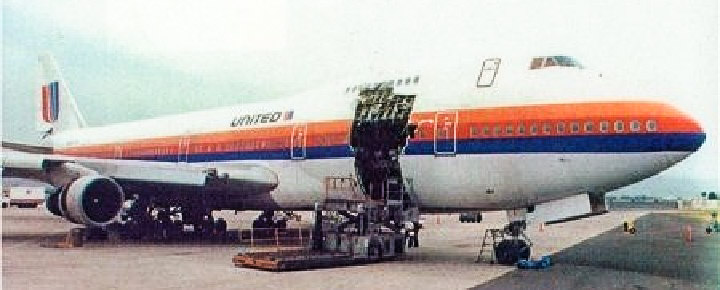When United Flight 811 from Honolulu ripped apart in mid-air
Sometimes we take flight safety for granted. But we were just reminded by video when United Airlines Flight 811 from Honolulu was ripped apart in mid-air shortly after takeoff. A massive explosive decompression ejected several rows of seats from the plane, and nine passengers were killed, whose bodies were never recovered. The flight departed from Los Angeles and landed uneventfully in Honolulu on its regular daily route to Sydney with stops. Nothing was reported as incorrect by the flight crew.
The event occurred on February 24, 1989, when the Boeing 747-100 cargo door failed shortly after takeoff from HNL. Miraculously, the badly damaged plane was able to return to Honolulu and land safely. The aircraft was later repaired and returned to service with United. The plane had flown nearly 60,000 flight hours on 15,000 flights prior to that day without incident.
After the Flight 811 accident, the aircraft was repaired and returned to service with UAL for another 8 years before moving to another airline where it flew until 1998.
The flight on that fateful day.
The flight was under the control of Captain David Cronin and was to be his last flight before reaching the then mandatory retirement age. The flight took off just before 2 a.m. in Hawaii with a total of 355 passengers and crew on board. As the plane climbed out of HNL at 23,000 feet, there was a loud noise followed by severe vibration. Fire believed to have been caused by a bomb, the aircraft’s forward cargo door had actually been ripped off. The door’s design was to swing outward rather than inward, and its force tore a large hole in the aircraft’s fuselage. Then the plane’s cabin floor caved in and 10 seats were ejected from the 747. Two of those seats were unoccupied, but the remaining seat occupants were killed.
A flight attendant was almost sucked out of the cabin, as happened on Aloha Airlines Flight 243, when it suffered explosive decompression just months earlier. The passengers and crew of the UAL 747 came to the aid of the flight attendant and were able to pull her back onto the plane. However, she suffered significant injuries.
Due to the current events, the flight crew suspected a bomb.
It was believed at the time that a bomb might have gone off on the 747, as happened on Pan Am’s Flight 103 just before Flight 811.
Emergency descent and preparation for landing.
A rapid descent to achieve breathable air was initiated as the plane returned to land in Honolulu. Due to the location of the explosion, emergency oxygen did not work.
Two of the four engines and more were damaged in the explosive decompression.
Flying parts of the aircraft damaged two of the four engines. Both had to be closed as a result. One of the wings was also dented and damaged.
Preparation for emergency landing at HNL.
Preparations were made for an emergency landing in Honolulu. The intercom system failed, preventing communication between the cockpit and cabin crew. The flight engineer went down to advise the cabin crew and find out what had happened. He mistakenly believed it was a bomb blast that caused the damage.
Despite not fully functioning landing flaps, the landing gear remained functional and a high-speed landing could be successfully initiated.
14 fateful minutes before landing.
Only 14 minutes elapsed from the moment of the explosion to the return to the HNL. Miraculously, upon landing, the entire aircraft was evacuated in less than 45 seconds.
Flight attendant heroes don’t have easy jobs.
It was reported that all of Flight 811’s flight attendants were injured during the incident and the evacuation.
The National Transportation Safety Board (NTSB).
The NTSB was initially unable to locate the missing cargo door, but came to their conclusion based on previous problems with cargo doors. Another 747 owned by Pan Am had a door incident at 20,000 feet that resulted in the flight being canceled. The door was open 1.5 inches on one edge. Investigators found that the locking mechanism was damaged. Boeing initially believed that this was caused by an error on the part of the ground crew,
The NTSB first determined that previous malfunctions in the plane’s forward cargo door damaged the door latch. As a result, it appeared to be locked and locked, but actually wasn’t. NTSB blamed UAL for improper maintenance and inspection.
However, further independent investigation led some to conclude that it was actually a design issue combined with an electrical issue that caused the door to open mid-flight. The design of an outward swinging door, which is more charge efficient, has also been seen as largely to blame. It was later reported that Boeing had known about a latch issue for almost 14 years. They had recommended changes to operating airlines, including moving from thin aluminum to heavier steel components. This was followed in July 1988 by a corresponding FAA airworthiness guideline, giving airlines up to two years to comply. After this incident, this was changed to a 30 day policy.
The cargo door was later recovered at a depth of 14,000 feet off Hawaii.
NTSB inspection found the theory of the locking mechanism to be incorrect. Based on developments, including another UAL 747 incident at JFK, an updated final report was issued in 1992, stating that the probable cause of the incident was a sudden opening of the cargo door due to a combination of improper wiring and cargo door defects. As a result of a short circuit, locking devices unexpectedly responded, aerodynamically allowing the door to blow off.
Fascinating reenactment video that reminds us of the incident.
Disclosure: We receive a small commission for purchases made through some of the links on Beat of Hawaii. These links cost you nothing and provide revenue necessary to bring our website to you. Mahalo! Privacy Policy and Disclosures.


Comments are closed.